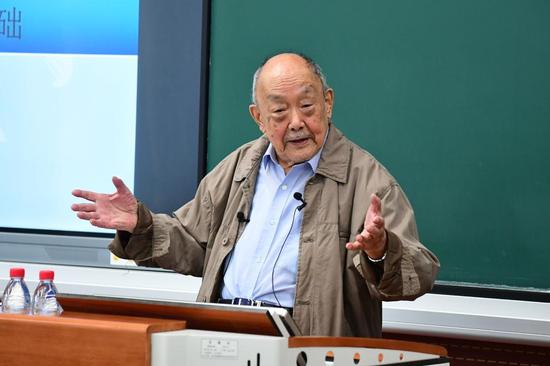Underwater acoustics pioneer recognized
Yang Shi'e, a pioneer of underwater acoustic engineering in China, has been posthumously awarded the title of "Role Model of the Time" by the Publicity Department of the Communist Party of China Central Committee.
Yang, an academician of the Chinese Academy of Engineering and professor at Harbin Engineering University, died on March 19 at the age of 93 in Harbin, the capital of Heilongjiang province.
Yang devoted himself to research on underwater acoustics, developing key core technologies and driving significant innovative breakthroughs.
In 1994, he led a team that completed the first large-scale, comprehensive deep-sea acoustic survey independently commanded and implemented by Chinese scientists.
Born in Tianjin in 1931, Yang experienced war and displacement from an early age, which instilled in him a strong desire to study to save and serve the country.
In September 1947, he began studying at the Physics Department of Tsinghua University.
In 1950, as the country urgently needed engineering and scientific talent who could handle and develop modern weapons and equipment, Yang, who was about to complete his studies at Tsinghua, chose to teach at the Dalian Naval Academy in Liaoning province and contribute to the construction of the national navy.
In 1952, the Central Military Commission decided to establish the PLA Military Engineering Institute, and Yang was appointed as one of its first instructors.
In 1956, he was sent to the former Soviet Union for further study in underwater acoustics.
At a Soviet acoustic institute, Yang found that two of the four research labs not open to Chinese graduate students were closely related to national defense.
"You can never learn or buy the truly cutting-edge technology from foreign countries," he said, vowing to become a pioneer in China's research on underwater acoustic engineering.
In 1960, Yang created China's first comprehensive underwater acoustics engineering department at the PLA Military Engineering Institute, combining science and engineering to serve national strategic interests.
He compiled a series of textbooks, including one of the earliest Chinese books to focus on underwater noise mechanisms.
From 1970 to 1980, as the head of the underwater measurement system, Yang developed the impact underwater acoustic measurement system for the DF-5, China's first intercontinental nuclear-capable missile, providing valuable experience and making significant contributions to the development of national marine engineering technologies.
In April 1994, two research vessels carrying the Chinese flag and nearly a hundred researchers sailed into the South China Sea.
As the head of the research team and chief scientist, Yang was extremely excited because it marked China's first strategically significant comprehensive underwater acoustics survey, as well as the first large-scale deep-sea acoustic survey independently commanded and implemented by Chinese scientists.
In 2016, the State Oceanic Administration awarded Yang the commemorative medal of "Lifetime Dedication to the Ocean".
Despite his advanced age, he continued to engage in front-line teaching and research, insisting on lecturing undergraduate students.
Yang trained over 110 master's and doctoral students in the field of underwater acoustics, with many of them forming the backbone of China's research and academic efforts in the field. All academicians in the field of underwater acoustic engineering in China have been guided by him.
He has been honored with titles such as "National Model Educator", "National Outstanding Science and Technology Worker", and "Model of Heilongjiang Province".

